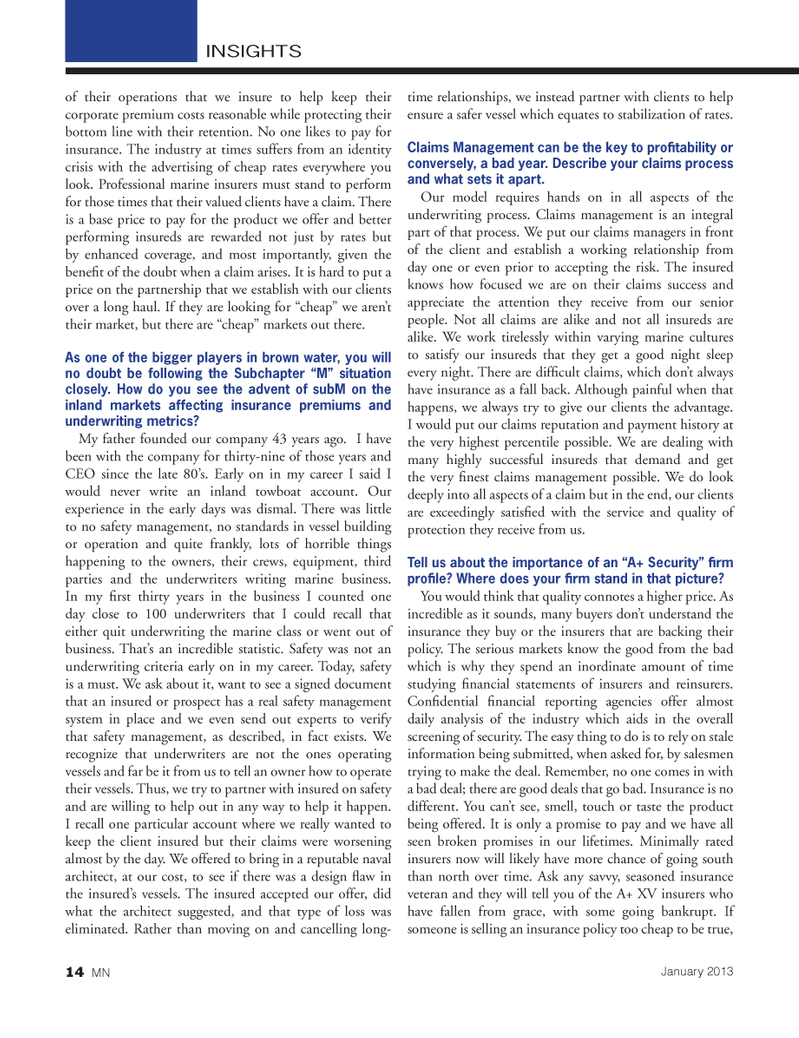
Page 14: of Marine News Magazine (January 2013)
Training and Education
Read this page in Pdf, Flash or Html5 edition of January 2013 Marine News Magazine
of their operations that we insure to help keep their corporate premium costs reasonable while protecting their bottom line with their retention. No one likes to pay for insurance. The industry at times suffers from an identity crisis with the advertising of cheap rates everywhere you look. Professional marine insurers must stand to perform for those times that their valued clients have a claim. There is a base price to pay for the product we offer and better performing insureds are rewarded not just by rates but by enhanced coverage, and most importantly, given the beneÞ t of the doubt when a claim arises. It is hard to put a price on the partnership that we establish with our clients over a long haul. If they are looking for ÒcheapÓ we arenÕt their market, but there are ÒcheapÓ markets out there. As one of the bigger players in brown water, you will no doubt be following the Subchapter ?M? situation closely. How do you see the advent of subM on the inland markets affecting insurance premiums and underwriting metrics? My father founded our company 43 years ago. I have been with the company for thirty-nine of those years and CEO since the late 80Õs. Early on in my career I said I would never write an inland towboat account. Our experience in the early days was dismal. There was little to no safety management, no standards in vessel building or operation and quite frankly, lots of horrible things happening to the owners, their crews, equipment, third parties and the underwriters writing marine business. In my Þ rst thirty years in the business I counted one day close to 100 underwriters that I could recall that either quit underwriting the marine class or went out of business. ThatÕs an incredible statistic. Safety was not an underwriting criteria early on in my career. Today, safety is a must. We ask about it, want to see a signed document that an insured or prospect has a real safety management system in place and we even send out experts to verify that safety management, as described, in fact exists. We recognize that underwriters are not the ones operating vessels and far be it from us to tell an owner how to operate their vessels. Thus, we try to partner with insured on safety and are willing to help out in any way to help it happen. I recall one particular account where we really wanted to keep the client insured but their claims were worsening almost by the day. We offered to bring in a reputable naval architect, at our cost, to see if there was a design ß aw in the insuredÕs vessels. The insured accepted our offer, did what the architect suggested, and that type of loss was eliminated. Rather than moving on and cancelling long- time relationships, we instead partner with clients to help ensure a safer vessel which equates to stabilization of rates. Claims Management can be the key to pro tability or conversely, a bad year. Describe your claims process and what sets it apart. Our model requires hands on in all aspects of the underwriting process. Claims management is an integral part of that process. We put our claims managers in front of the client and establish a working relationship from day one or even prior to accepting the risk. The insured knows how focused we are on their claims success and appreciate the attention they receive from our senior people. Not all claims are alike and not all insureds are alike. We work tirelessly within varying marine cultures to satisfy our insureds that they get a good night sleep every night. There are difÞ cult claims, which donÕt always have insurance as a fall back. Although painful when that happens, we always try to give our clients the advantage. I would put our claims reputation and payment history at the very highest percentile possible. We are dealing with many highly successful insureds that demand and get the very Þ nest claims management possible. We do look deeply into all aspects of a claim but in the end, our clients are exceedingly satisÞ ed with the service and quality of protection they receive from us. Tell us about the importance of an ?A+ Security? rm pro le? Where does your rm stand in that picture? You would think that quality connotes a higher price. As incredible as it sounds, many buyers donÕt understand the insurance they buy or the insurers that are backing their policy. The serious markets know the good from the bad which is why they spend an inordinate amount of time studying Þ nancial statements of insurers and reinsurers. ConÞ dential Þ nancial reporting agencies offer almost daily analysis of the industry which aids in the overall screening of security. The easy thing to do is to rely on stale information being submitted, when asked for, by salesmen trying to make the deal. Remember, no one comes in with a bad deal; there are good deals that go bad. Insurance is no different. You canÕt see, smell, touch or taste the product being offered. It is only a promise to pay and we have all seen broken promises in our lifetimes. Minimally rated insurers now will likely have more chance of going south than north over time. Ask any savvy, seasoned insurance veteran and they will tell you of the A+ XV insurers who have fallen from grace, with some going bankrupt. If someone is selling an insurance policy too cheap to be true, INSIGHTS14 MNJanuary 2013 MN Jan2013 Layout 1-17.indd 14MN Jan2013 Layout 1-17.indd 141/2/2013 3:16:05 PM1/2/2013 3:16:05 PM

 13
13

 15
15
